Web Site Investigation and Analysis - Desklib
VerifiedAdded on 2023/06/08
|19
|1966
|135
AI Summary
This article discusses the analysis of Desklib's website content, navigation, and user interaction model. It includes a user hierarchical diagram, use case analysis, activity diagrams, and high-level requirements. The article also identifies epics and product features under each epic for the initial product backlog. The subject is SIT725 Software Engineering, and the course code is Trimester 2, 2018. The article is relevant to students studying software engineering and web development.
Contribute Materials
Your contribution can guide someone’s learning journey. Share your
documents today.
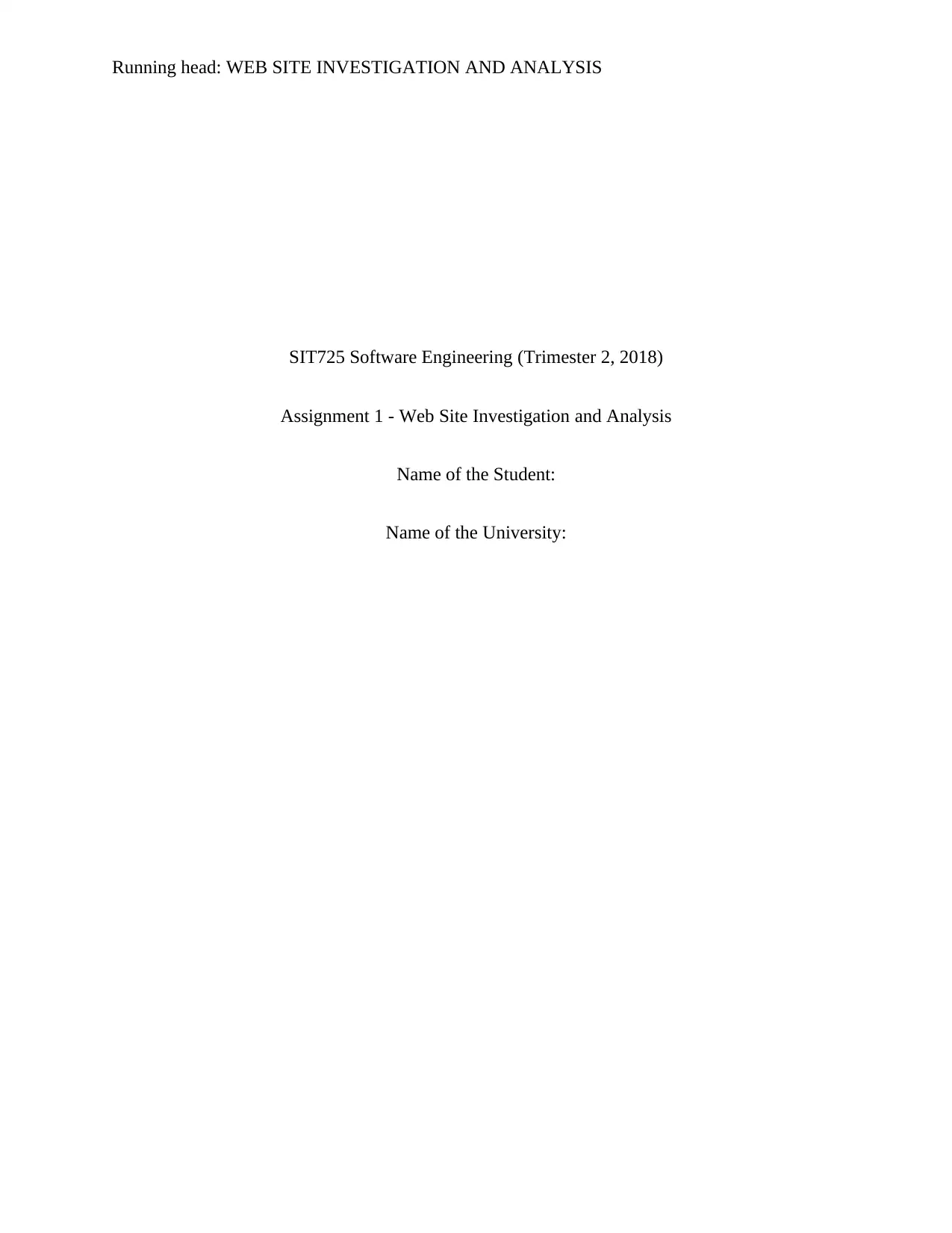
Running head: WEB SITE INVESTIGATION AND ANALYSIS
SIT725 Software Engineering (Trimester 2, 2018)
Assignment 1 - Web Site Investigation and Analysis
Name of the Student:
Name of the University:
SIT725 Software Engineering (Trimester 2, 2018)
Assignment 1 - Web Site Investigation and Analysis
Name of the Student:
Name of the University:
Secure Best Marks with AI Grader
Need help grading? Try our AI Grader for instant feedback on your assignments.
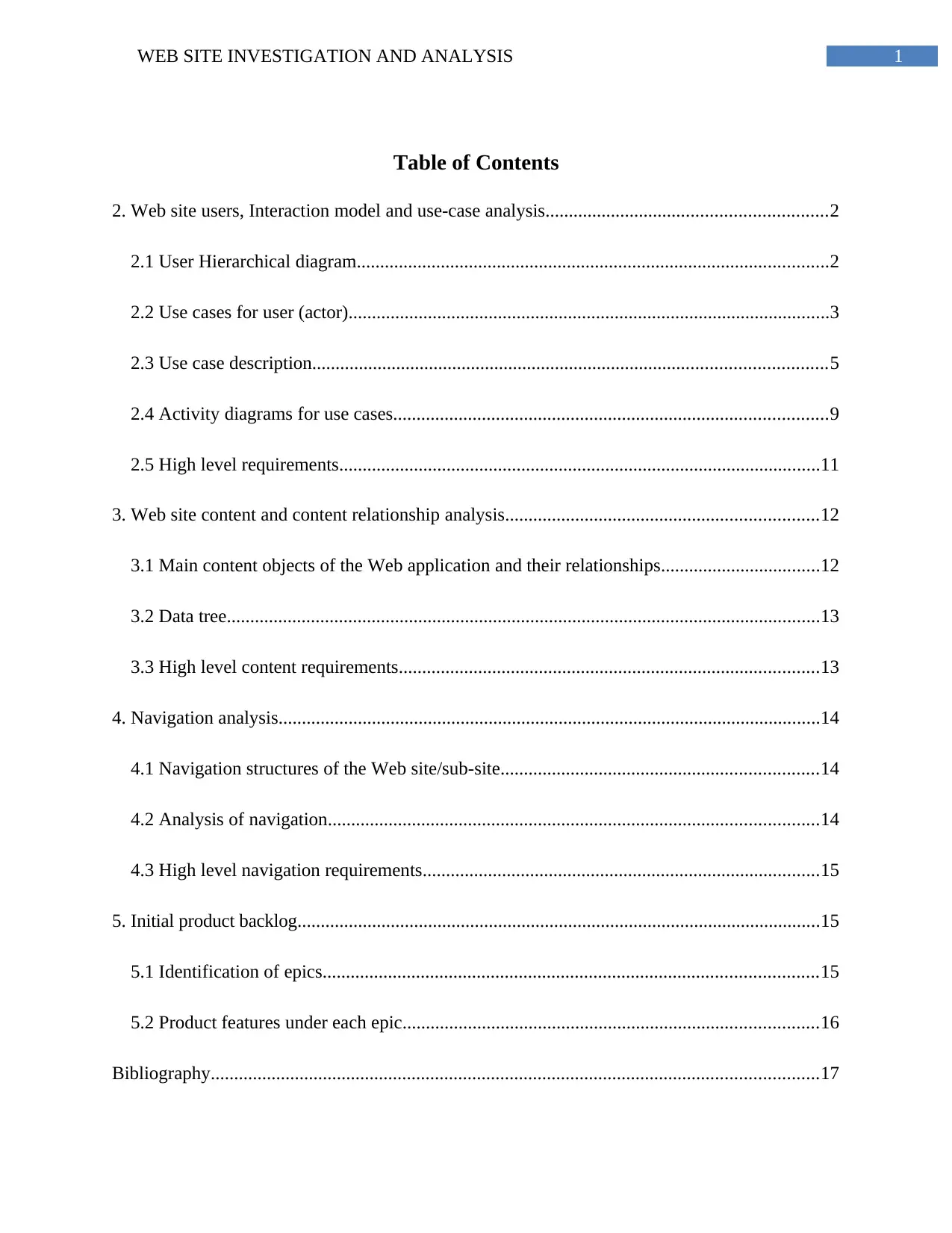
1WEB SITE INVESTIGATION AND ANALYSIS
Table of Contents
2. Web site users, Interaction model and use-case analysis............................................................2
2.1 User Hierarchical diagram.....................................................................................................2
2.2 Use cases for user (actor).......................................................................................................3
2.3 Use case description..............................................................................................................5
2.4 Activity diagrams for use cases.............................................................................................9
2.5 High level requirements.......................................................................................................11
3. Web site content and content relationship analysis...................................................................12
3.1 Main content objects of the Web application and their relationships..................................12
3.2 Data tree...............................................................................................................................13
3.3 High level content requirements..........................................................................................13
4. Navigation analysis....................................................................................................................14
4.1 Navigation structures of the Web site/sub-site....................................................................14
4.2 Analysis of navigation.........................................................................................................14
4.3 High level navigation requirements.....................................................................................15
5. Initial product backlog................................................................................................................15
5.1 Identification of epics..........................................................................................................15
5.2 Product features under each epic.........................................................................................16
Bibliography..................................................................................................................................17
Table of Contents
2. Web site users, Interaction model and use-case analysis............................................................2
2.1 User Hierarchical diagram.....................................................................................................2
2.2 Use cases for user (actor).......................................................................................................3
2.3 Use case description..............................................................................................................5
2.4 Activity diagrams for use cases.............................................................................................9
2.5 High level requirements.......................................................................................................11
3. Web site content and content relationship analysis...................................................................12
3.1 Main content objects of the Web application and their relationships..................................12
3.2 Data tree...............................................................................................................................13
3.3 High level content requirements..........................................................................................13
4. Navigation analysis....................................................................................................................14
4.1 Navigation structures of the Web site/sub-site....................................................................14
4.2 Analysis of navigation.........................................................................................................14
4.3 High level navigation requirements.....................................................................................15
5. Initial product backlog................................................................................................................15
5.1 Identification of epics..........................................................................................................15
5.2 Product features under each epic.........................................................................................16
Bibliography..................................................................................................................................17
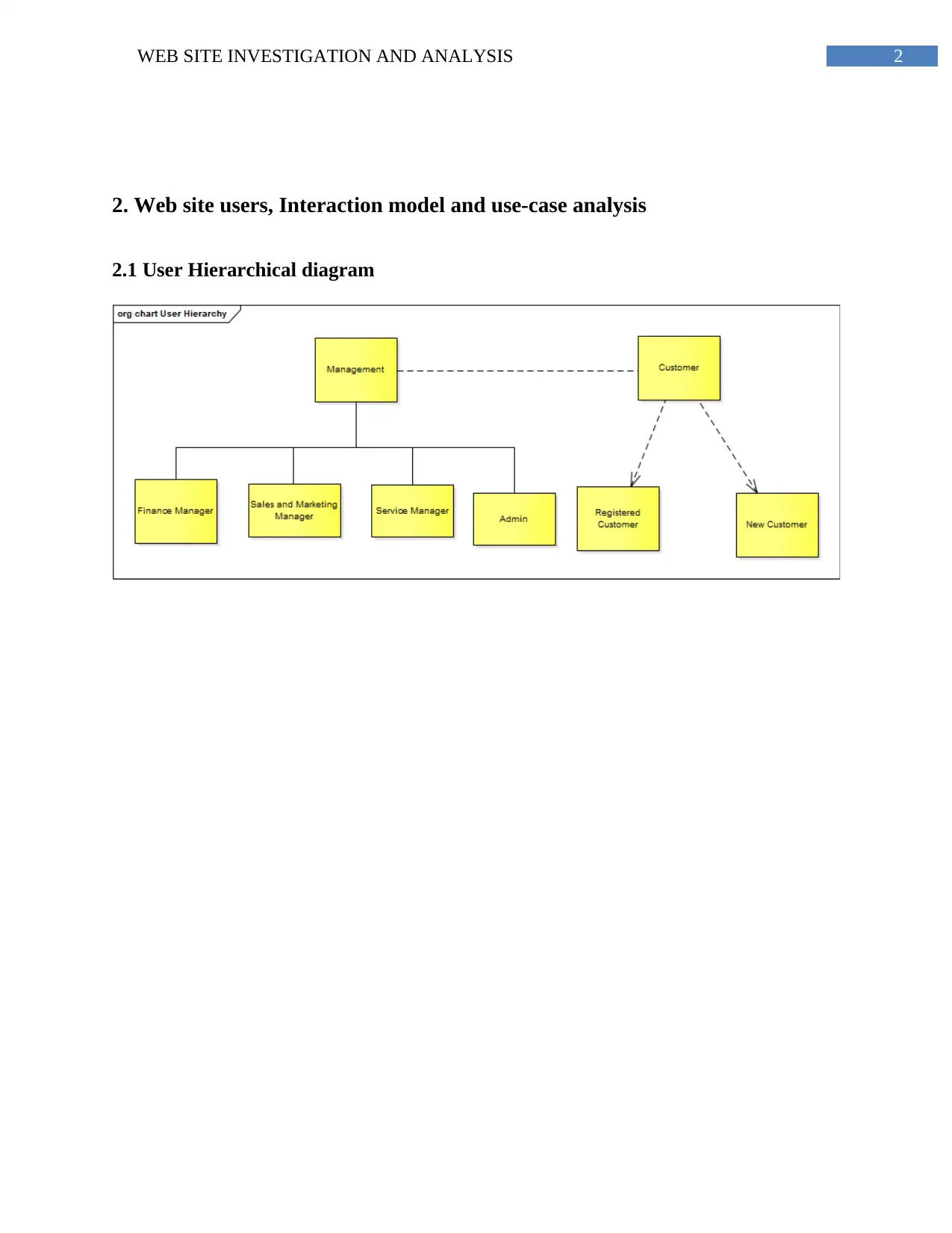
2WEB SITE INVESTIGATION AND ANALYSIS
2. Web site users, Interaction model and use-case analysis
2.1 User Hierarchical diagram
2. Web site users, Interaction model and use-case analysis
2.1 User Hierarchical diagram
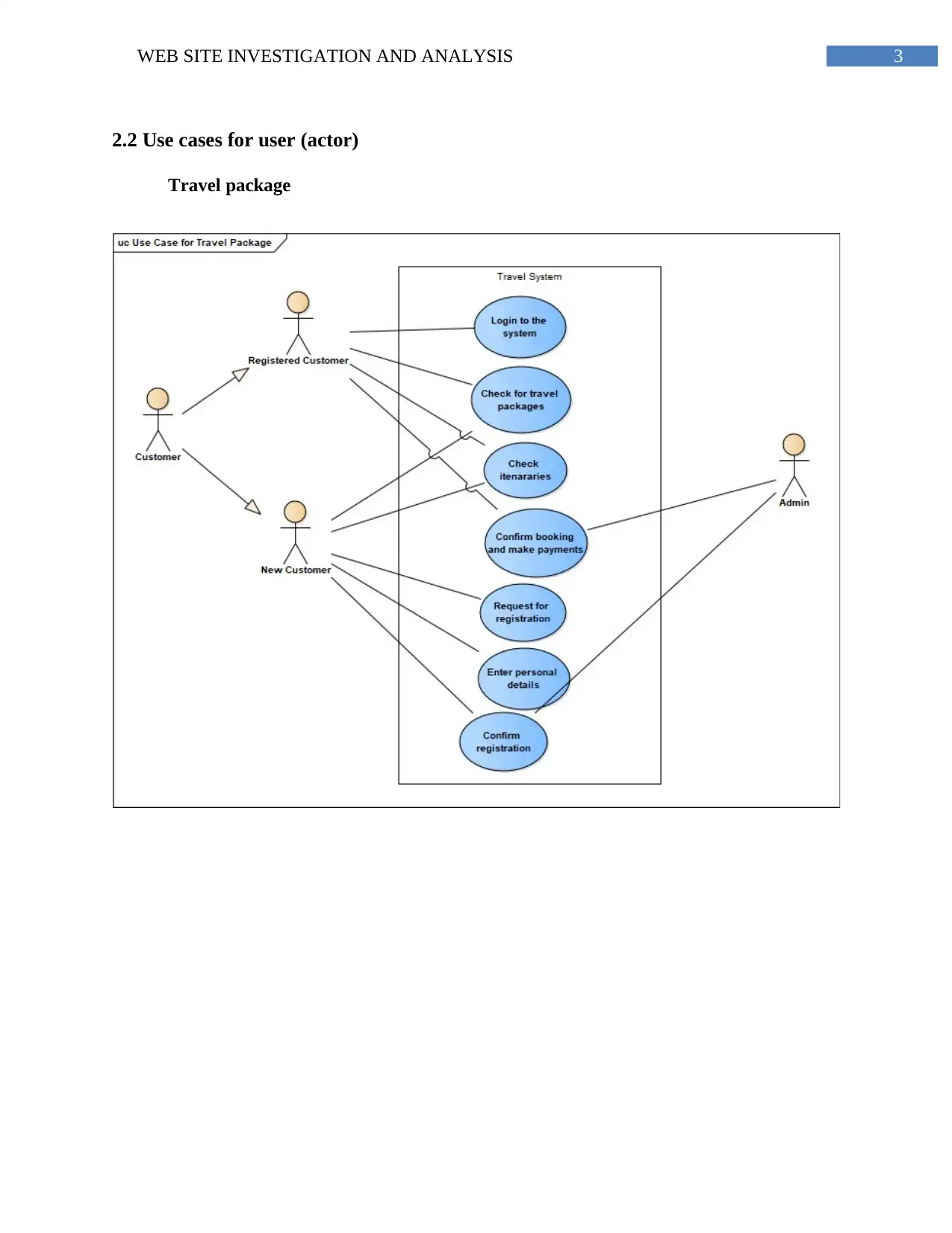
3WEB SITE INVESTIGATION AND ANALYSIS
2.2 Use cases for user (actor)
Travel package
2.2 Use cases for user (actor)
Travel package
Secure Best Marks with AI Grader
Need help grading? Try our AI Grader for instant feedback on your assignments.
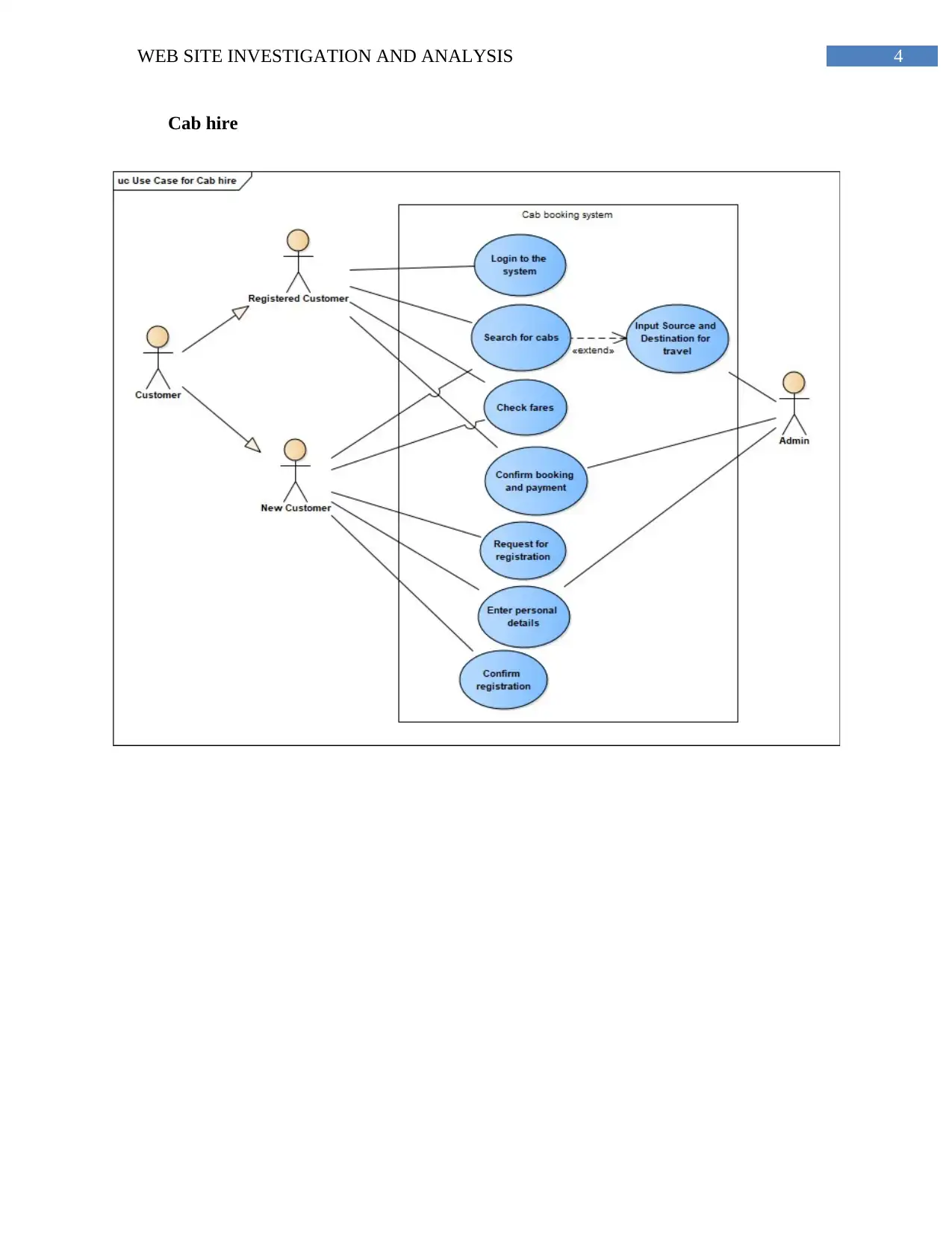
4WEB SITE INVESTIGATION AND ANALYSIS
Cab hire
Cab hire
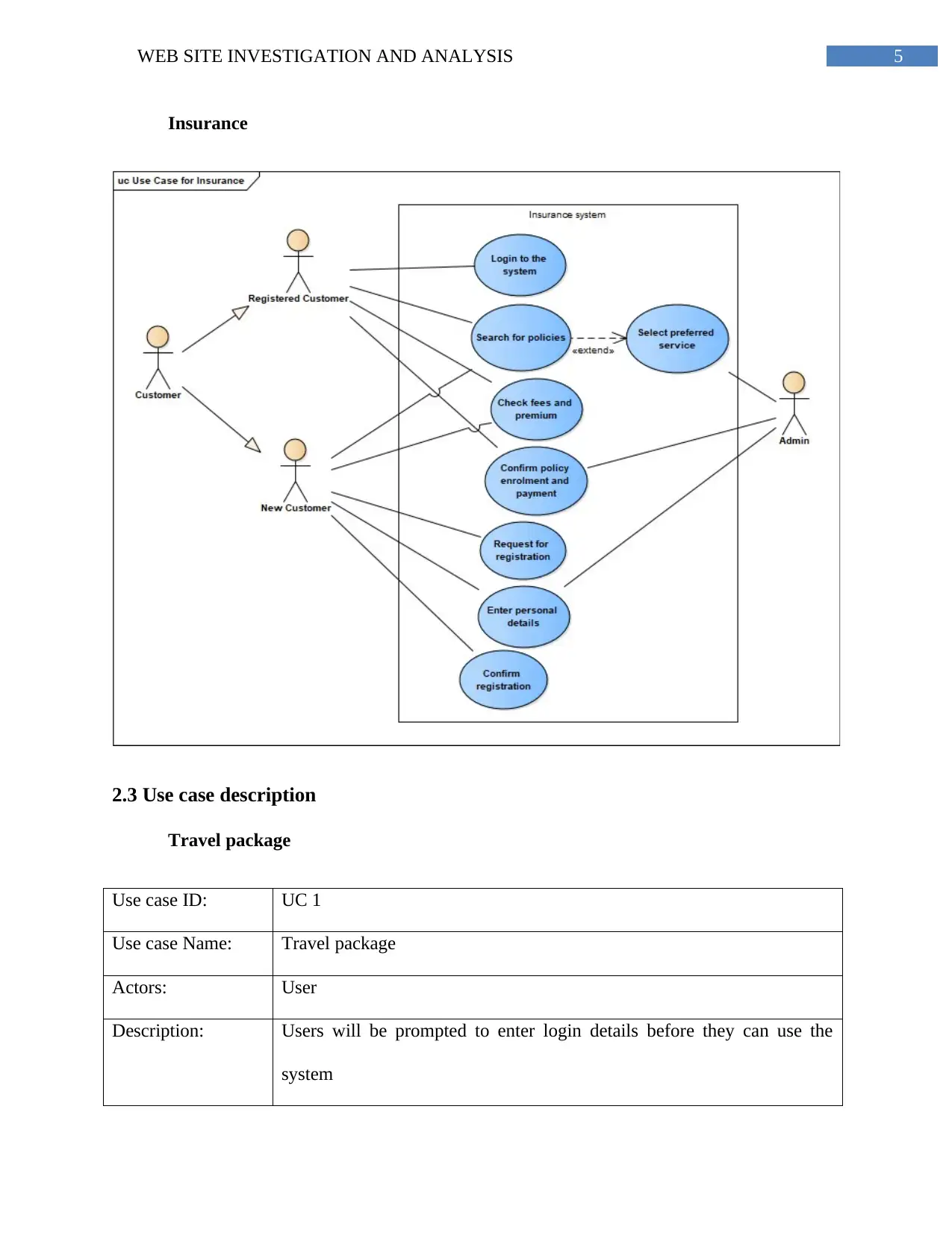
5WEB SITE INVESTIGATION AND ANALYSIS
Insurance
2.3 Use case description
Travel package
Use case ID: UC 1
Use case Name: Travel package
Actors: User
Description: Users will be prompted to enter login details before they can use the
system
Insurance
2.3 Use case description
Travel package
Use case ID: UC 1
Use case Name: Travel package
Actors: User
Description: Users will be prompted to enter login details before they can use the
system
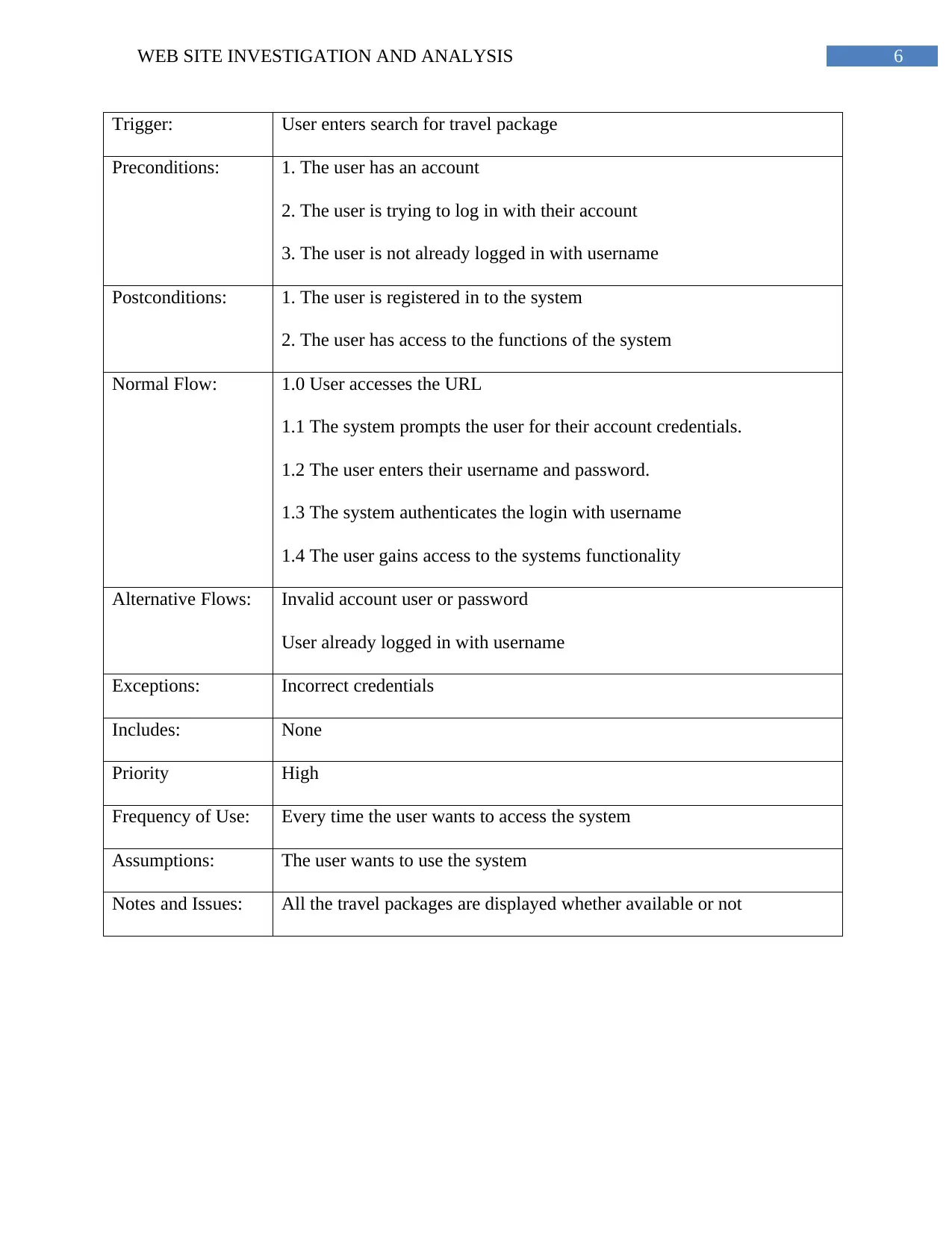
6WEB SITE INVESTIGATION AND ANALYSIS
Trigger: User enters search for travel package
Preconditions: 1. The user has an account
2. The user is trying to log in with their account
3. The user is not already logged in with username
Postconditions: 1. The user is registered in to the system
2. The user has access to the functions of the system
Normal Flow: 1.0 User accesses the URL
1.1 The system prompts the user for their account credentials.
1.2 The user enters their username and password.
1.3 The system authenticates the login with username
1.4 The user gains access to the systems functionality
Alternative Flows: Invalid account user or password
User already logged in with username
Exceptions: Incorrect credentials
Includes: None
Priority High
Frequency of Use: Every time the user wants to access the system
Assumptions: The user wants to use the system
Notes and Issues: All the travel packages are displayed whether available or not
Trigger: User enters search for travel package
Preconditions: 1. The user has an account
2. The user is trying to log in with their account
3. The user is not already logged in with username
Postconditions: 1. The user is registered in to the system
2. The user has access to the functions of the system
Normal Flow: 1.0 User accesses the URL
1.1 The system prompts the user for their account credentials.
1.2 The user enters their username and password.
1.3 The system authenticates the login with username
1.4 The user gains access to the systems functionality
Alternative Flows: Invalid account user or password
User already logged in with username
Exceptions: Incorrect credentials
Includes: None
Priority High
Frequency of Use: Every time the user wants to access the system
Assumptions: The user wants to use the system
Notes and Issues: All the travel packages are displayed whether available or not
Paraphrase This Document
Need a fresh take? Get an instant paraphrase of this document with our AI Paraphraser
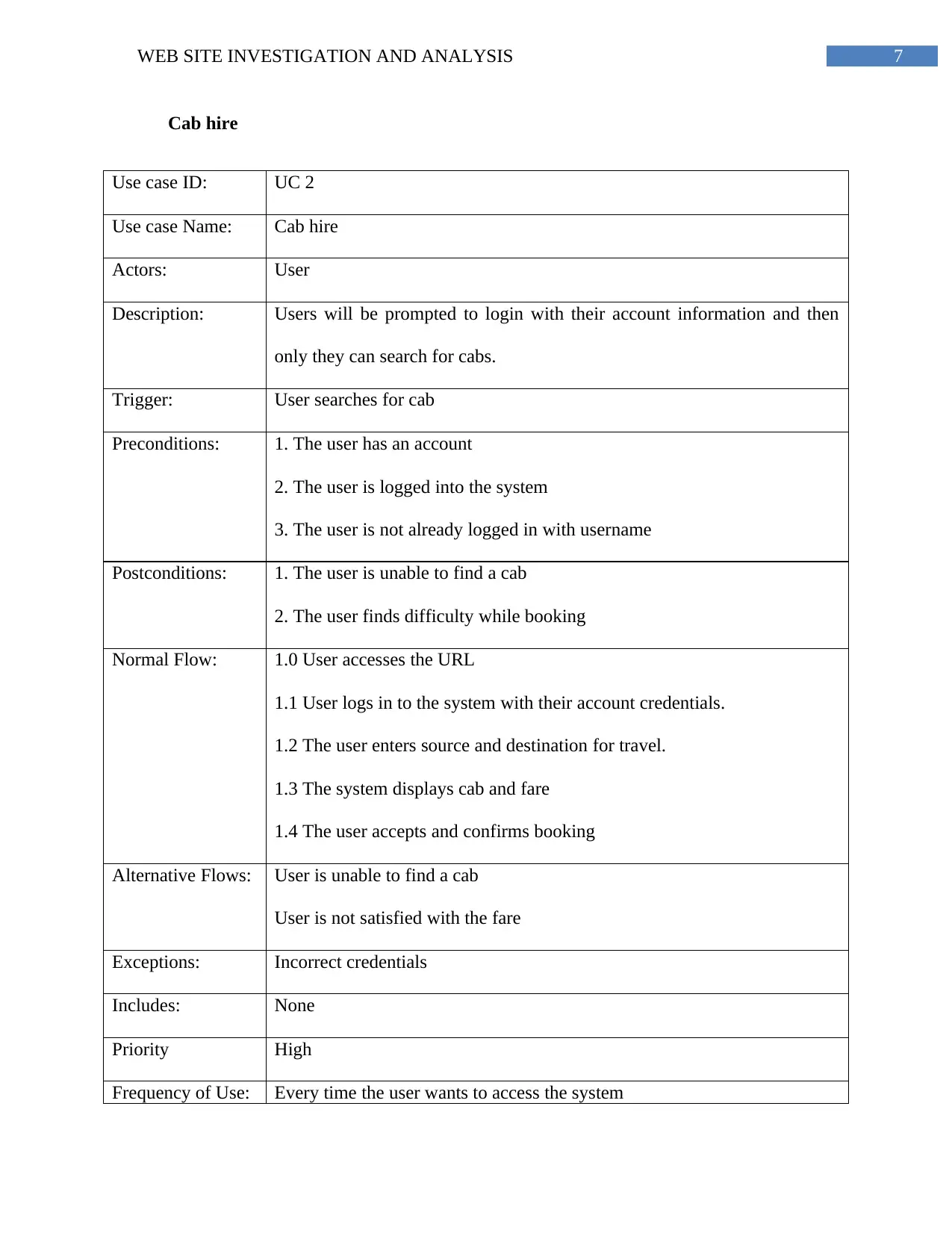
7WEB SITE INVESTIGATION AND ANALYSIS
Cab hire
Use case ID: UC 2
Use case Name: Cab hire
Actors: User
Description: Users will be prompted to login with their account information and then
only they can search for cabs.
Trigger: User searches for cab
Preconditions: 1. The user has an account
2. The user is logged into the system
3. The user is not already logged in with username
Postconditions: 1. The user is unable to find a cab
2. The user finds difficulty while booking
Normal Flow: 1.0 User accesses the URL
1.1 User logs in to the system with their account credentials.
1.2 The user enters source and destination for travel.
1.3 The system displays cab and fare
1.4 The user accepts and confirms booking
Alternative Flows: User is unable to find a cab
User is not satisfied with the fare
Exceptions: Incorrect credentials
Includes: None
Priority High
Frequency of Use: Every time the user wants to access the system
Cab hire
Use case ID: UC 2
Use case Name: Cab hire
Actors: User
Description: Users will be prompted to login with their account information and then
only they can search for cabs.
Trigger: User searches for cab
Preconditions: 1. The user has an account
2. The user is logged into the system
3. The user is not already logged in with username
Postconditions: 1. The user is unable to find a cab
2. The user finds difficulty while booking
Normal Flow: 1.0 User accesses the URL
1.1 User logs in to the system with their account credentials.
1.2 The user enters source and destination for travel.
1.3 The system displays cab and fare
1.4 The user accepts and confirms booking
Alternative Flows: User is unable to find a cab
User is not satisfied with the fare
Exceptions: Incorrect credentials
Includes: None
Priority High
Frequency of Use: Every time the user wants to access the system
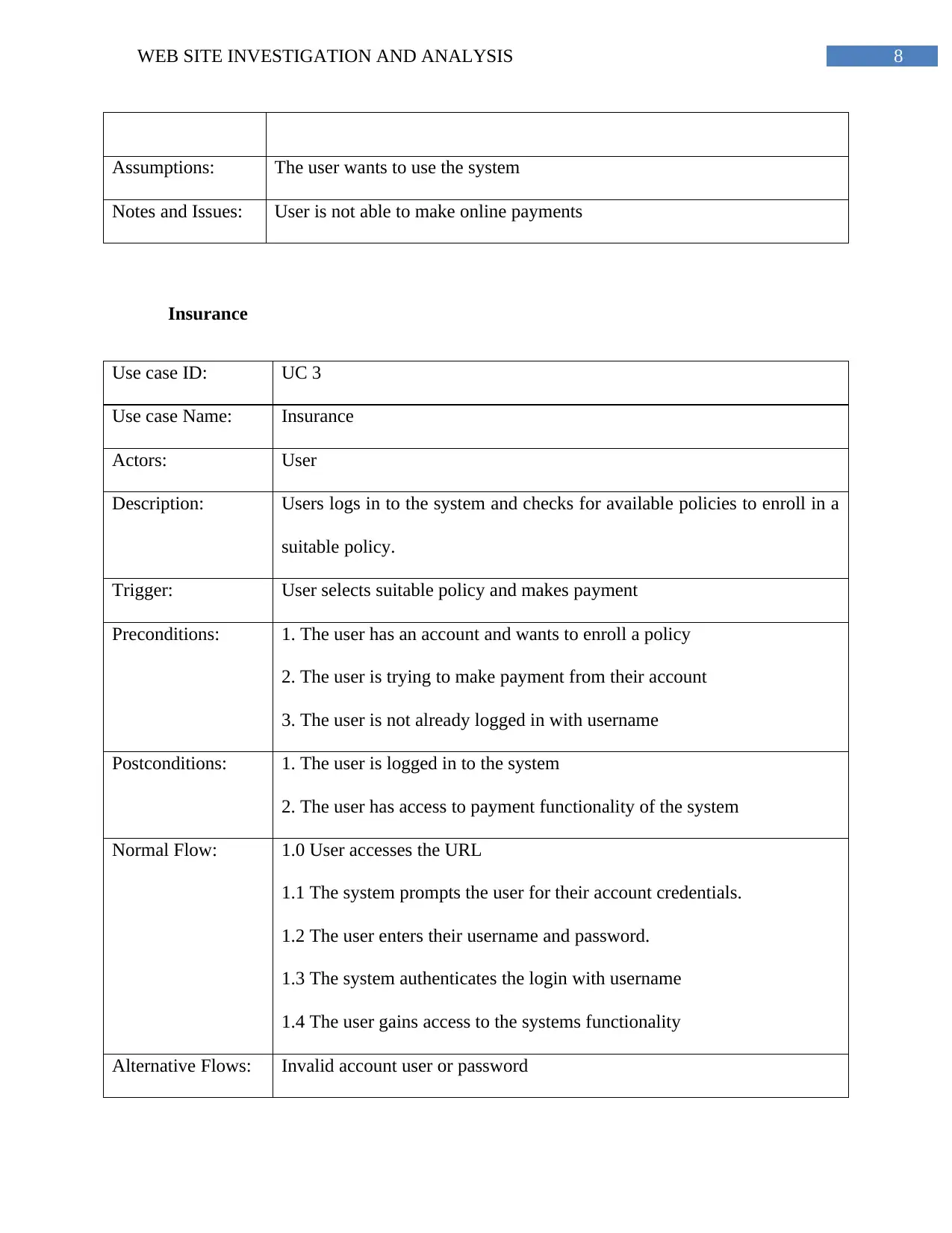
8WEB SITE INVESTIGATION AND ANALYSIS
Assumptions: The user wants to use the system
Notes and Issues: User is not able to make online payments
Insurance
Use case ID: UC 3
Use case Name: Insurance
Actors: User
Description: Users logs in to the system and checks for available policies to enroll in a
suitable policy.
Trigger: User selects suitable policy and makes payment
Preconditions: 1. The user has an account and wants to enroll a policy
2. The user is trying to make payment from their account
3. The user is not already logged in with username
Postconditions: 1. The user is logged in to the system
2. The user has access to payment functionality of the system
Normal Flow: 1.0 User accesses the URL
1.1 The system prompts the user for their account credentials.
1.2 The user enters their username and password.
1.3 The system authenticates the login with username
1.4 The user gains access to the systems functionality
Alternative Flows: Invalid account user or password
Assumptions: The user wants to use the system
Notes and Issues: User is not able to make online payments
Insurance
Use case ID: UC 3
Use case Name: Insurance
Actors: User
Description: Users logs in to the system and checks for available policies to enroll in a
suitable policy.
Trigger: User selects suitable policy and makes payment
Preconditions: 1. The user has an account and wants to enroll a policy
2. The user is trying to make payment from their account
3. The user is not already logged in with username
Postconditions: 1. The user is logged in to the system
2. The user has access to payment functionality of the system
Normal Flow: 1.0 User accesses the URL
1.1 The system prompts the user for their account credentials.
1.2 The user enters their username and password.
1.3 The system authenticates the login with username
1.4 The user gains access to the systems functionality
Alternative Flows: Invalid account user or password
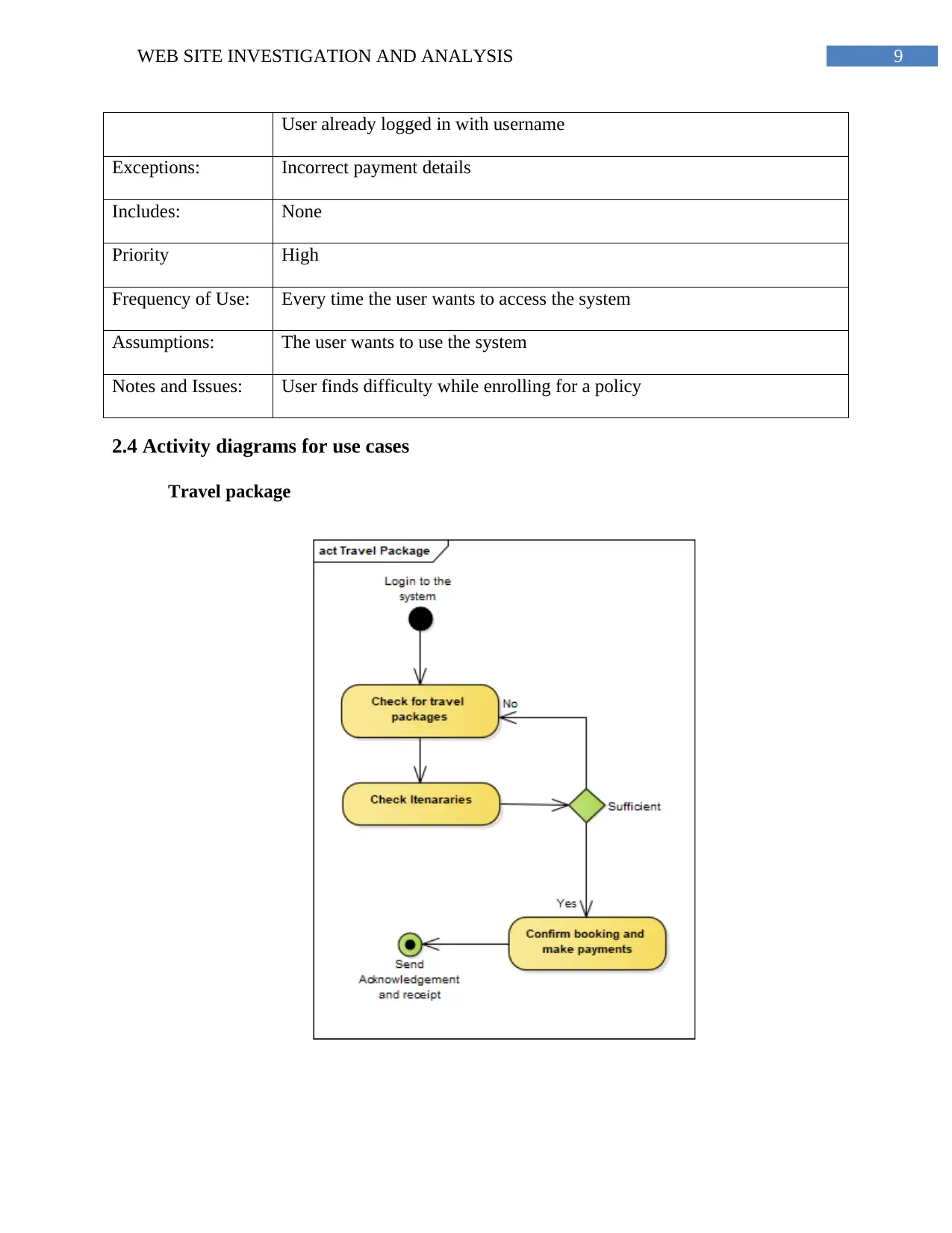
9WEB SITE INVESTIGATION AND ANALYSIS
User already logged in with username
Exceptions: Incorrect payment details
Includes: None
Priority High
Frequency of Use: Every time the user wants to access the system
Assumptions: The user wants to use the system
Notes and Issues: User finds difficulty while enrolling for a policy
2.4 Activity diagrams for use cases
Travel package
User already logged in with username
Exceptions: Incorrect payment details
Includes: None
Priority High
Frequency of Use: Every time the user wants to access the system
Assumptions: The user wants to use the system
Notes and Issues: User finds difficulty while enrolling for a policy
2.4 Activity diagrams for use cases
Travel package
Secure Best Marks with AI Grader
Need help grading? Try our AI Grader for instant feedback on your assignments.
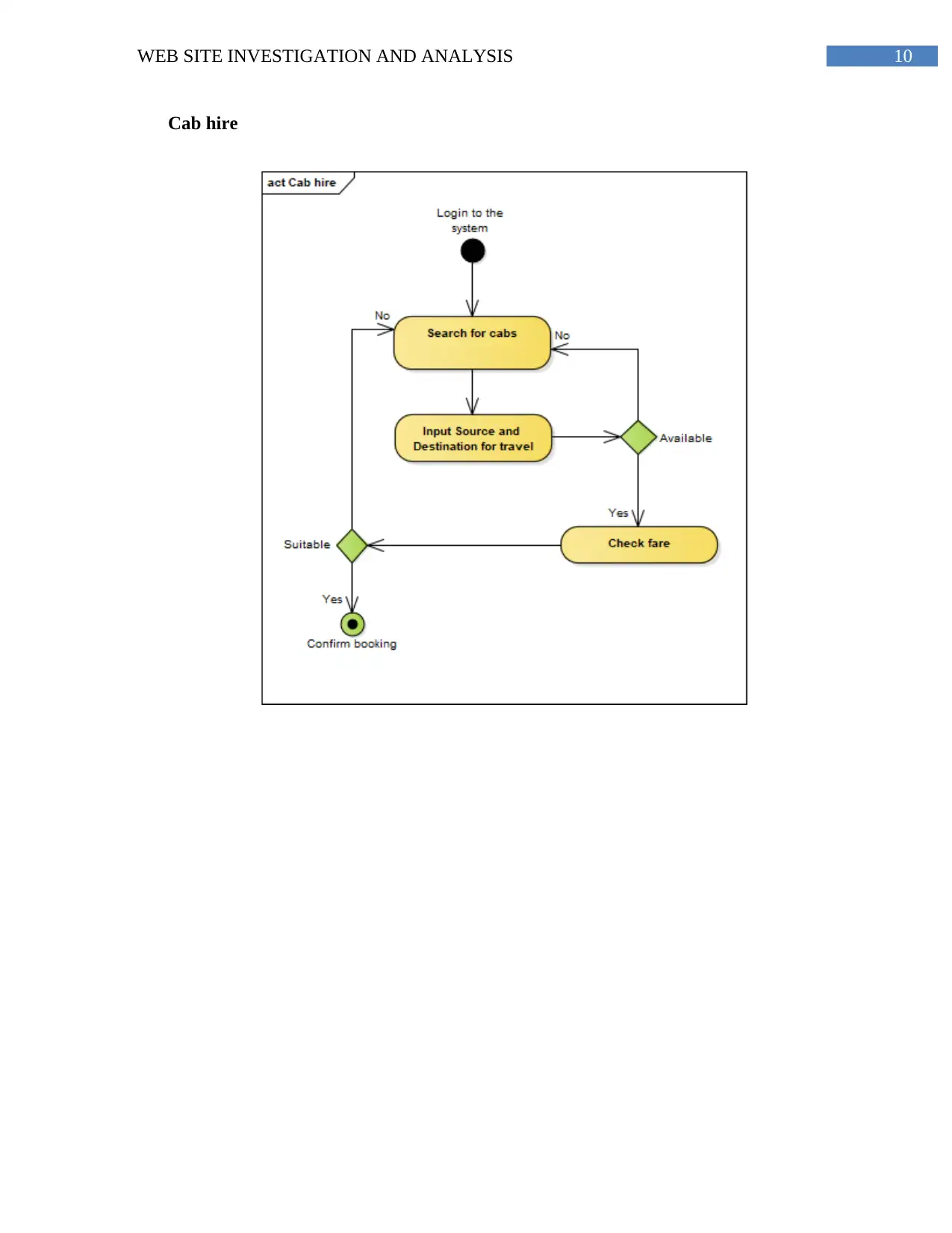
10WEB SITE INVESTIGATION AND ANALYSIS
Cab hire
Cab hire
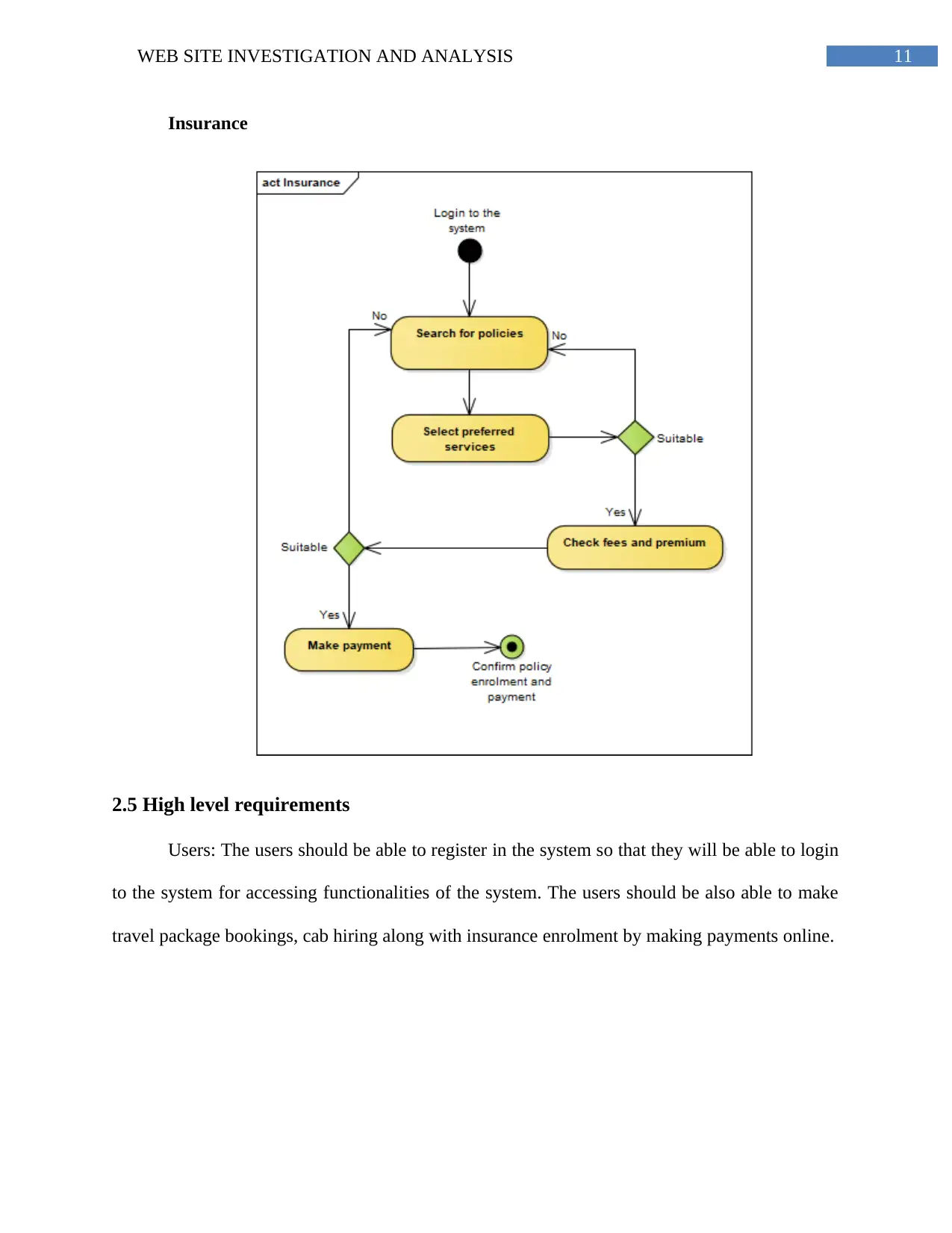
11WEB SITE INVESTIGATION AND ANALYSIS
Insurance
2.5 High level requirements
Users: The users should be able to register in the system so that they will be able to login
to the system for accessing functionalities of the system. The users should be also able to make
travel package bookings, cab hiring along with insurance enrolment by making payments online.
Insurance
2.5 High level requirements
Users: The users should be able to register in the system so that they will be able to login
to the system for accessing functionalities of the system. The users should be also able to make
travel package bookings, cab hiring along with insurance enrolment by making payments online.
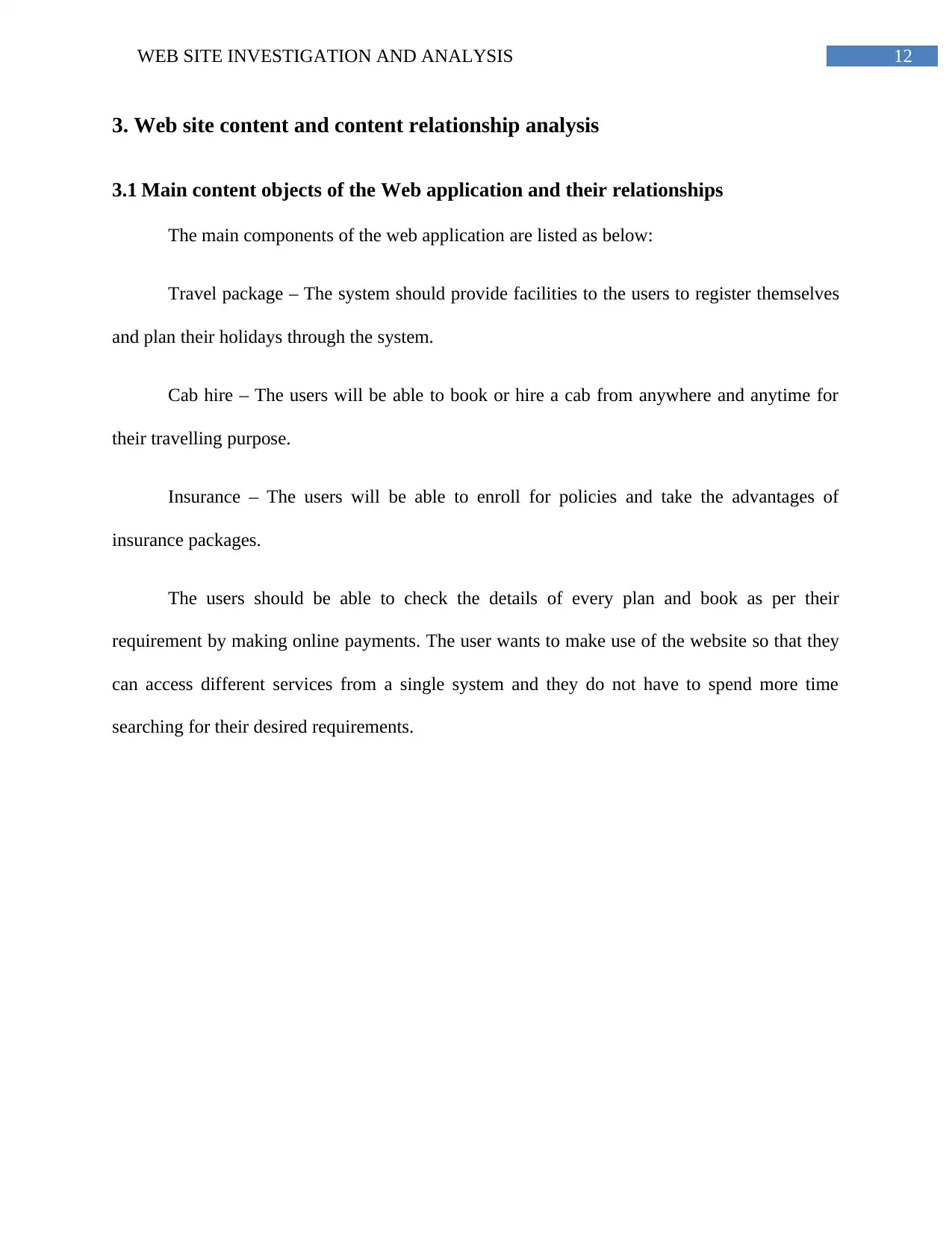
12WEB SITE INVESTIGATION AND ANALYSIS
3. Web site content and content relationship analysis
3.1 Main content objects of the Web application and their relationships
The main components of the web application are listed as below:
Travel package – The system should provide facilities to the users to register themselves
and plan their holidays through the system.
Cab hire – The users will be able to book or hire a cab from anywhere and anytime for
their travelling purpose.
Insurance – The users will be able to enroll for policies and take the advantages of
insurance packages.
The users should be able to check the details of every plan and book as per their
requirement by making online payments. The user wants to make use of the website so that they
can access different services from a single system and they do not have to spend more time
searching for their desired requirements.
3. Web site content and content relationship analysis
3.1 Main content objects of the Web application and their relationships
The main components of the web application are listed as below:
Travel package – The system should provide facilities to the users to register themselves
and plan their holidays through the system.
Cab hire – The users will be able to book or hire a cab from anywhere and anytime for
their travelling purpose.
Insurance – The users will be able to enroll for policies and take the advantages of
insurance packages.
The users should be able to check the details of every plan and book as per their
requirement by making online payments. The user wants to make use of the website so that they
can access different services from a single system and they do not have to spend more time
searching for their desired requirements.
Paraphrase This Document
Need a fresh take? Get an instant paraphrase of this document with our AI Paraphraser
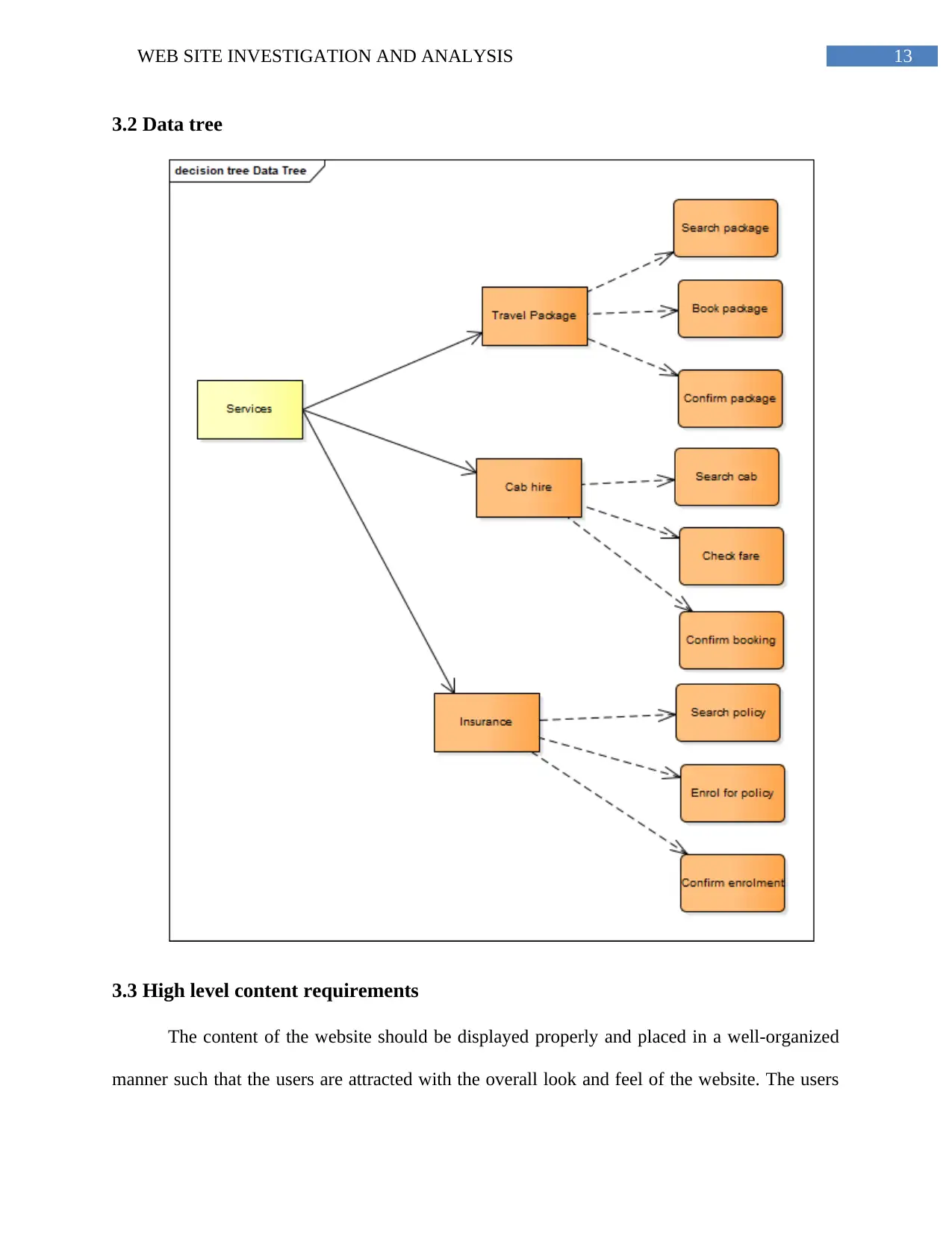
13WEB SITE INVESTIGATION AND ANALYSIS
3.2 Data tree
3.3 High level content requirements
The content of the website should be displayed properly and placed in a well-organized
manner such that the users are attracted with the overall look and feel of the website. The users
3.2 Data tree
3.3 High level content requirements
The content of the website should be displayed properly and placed in a well-organized
manner such that the users are attracted with the overall look and feel of the website. The users
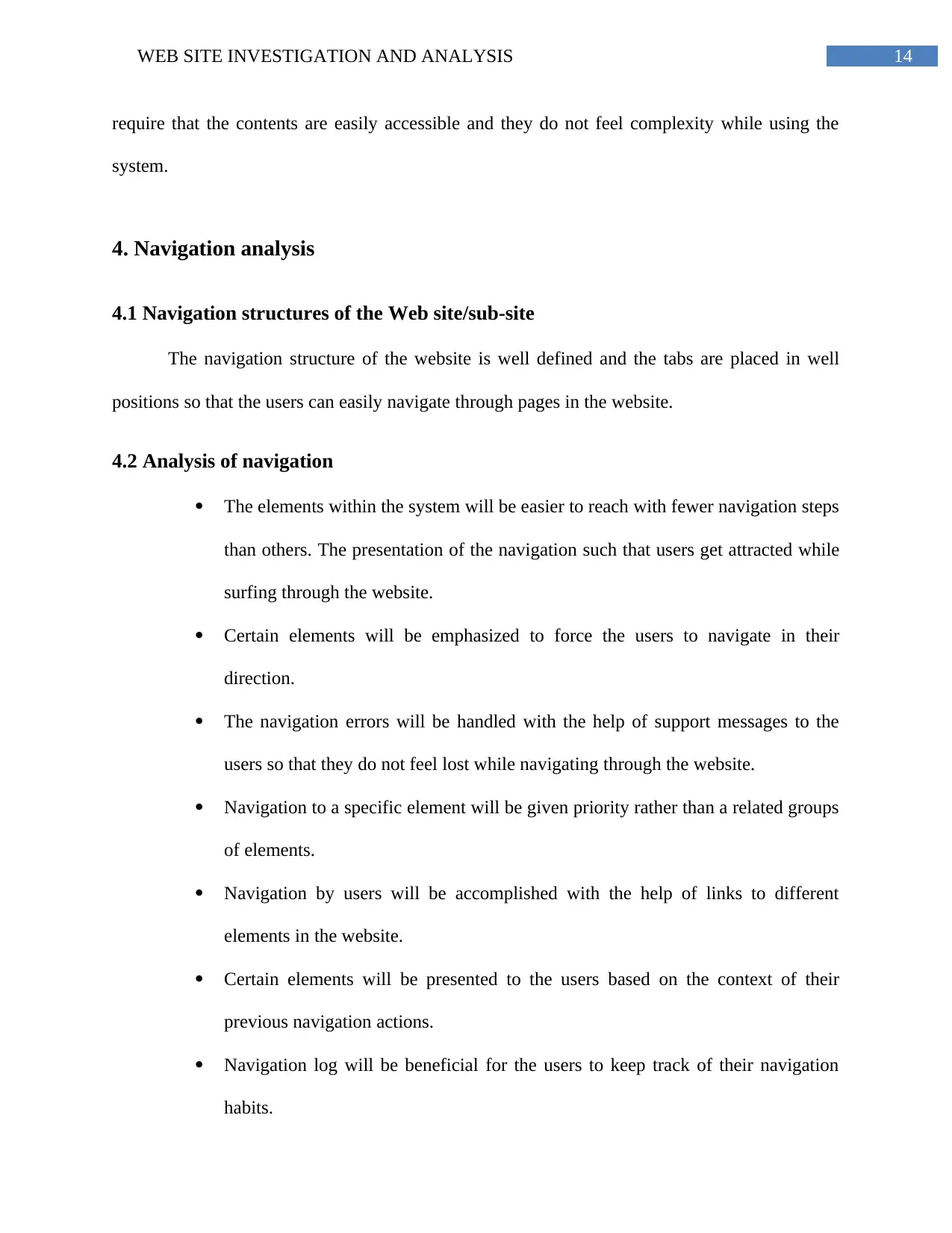
14WEB SITE INVESTIGATION AND ANALYSIS
require that the contents are easily accessible and they do not feel complexity while using the
system.
4. Navigation analysis
4.1 Navigation structures of the Web site/sub-site
The navigation structure of the website is well defined and the tabs are placed in well
positions so that the users can easily navigate through pages in the website.
4.2 Analysis of navigation
The elements within the system will be easier to reach with fewer navigation steps
than others. The presentation of the navigation such that users get attracted while
surfing through the website.
Certain elements will be emphasized to force the users to navigate in their
direction.
The navigation errors will be handled with the help of support messages to the
users so that they do not feel lost while navigating through the website.
Navigation to a specific element will be given priority rather than a related groups
of elements.
Navigation by users will be accomplished with the help of links to different
elements in the website.
Certain elements will be presented to the users based on the context of their
previous navigation actions.
Navigation log will be beneficial for the users to keep track of their navigation
habits.
require that the contents are easily accessible and they do not feel complexity while using the
system.
4. Navigation analysis
4.1 Navigation structures of the Web site/sub-site
The navigation structure of the website is well defined and the tabs are placed in well
positions so that the users can easily navigate through pages in the website.
4.2 Analysis of navigation
The elements within the system will be easier to reach with fewer navigation steps
than others. The presentation of the navigation such that users get attracted while
surfing through the website.
Certain elements will be emphasized to force the users to navigate in their
direction.
The navigation errors will be handled with the help of support messages to the
users so that they do not feel lost while navigating through the website.
Navigation to a specific element will be given priority rather than a related groups
of elements.
Navigation by users will be accomplished with the help of links to different
elements in the website.
Certain elements will be presented to the users based on the context of their
previous navigation actions.
Navigation log will be beneficial for the users to keep track of their navigation
habits.
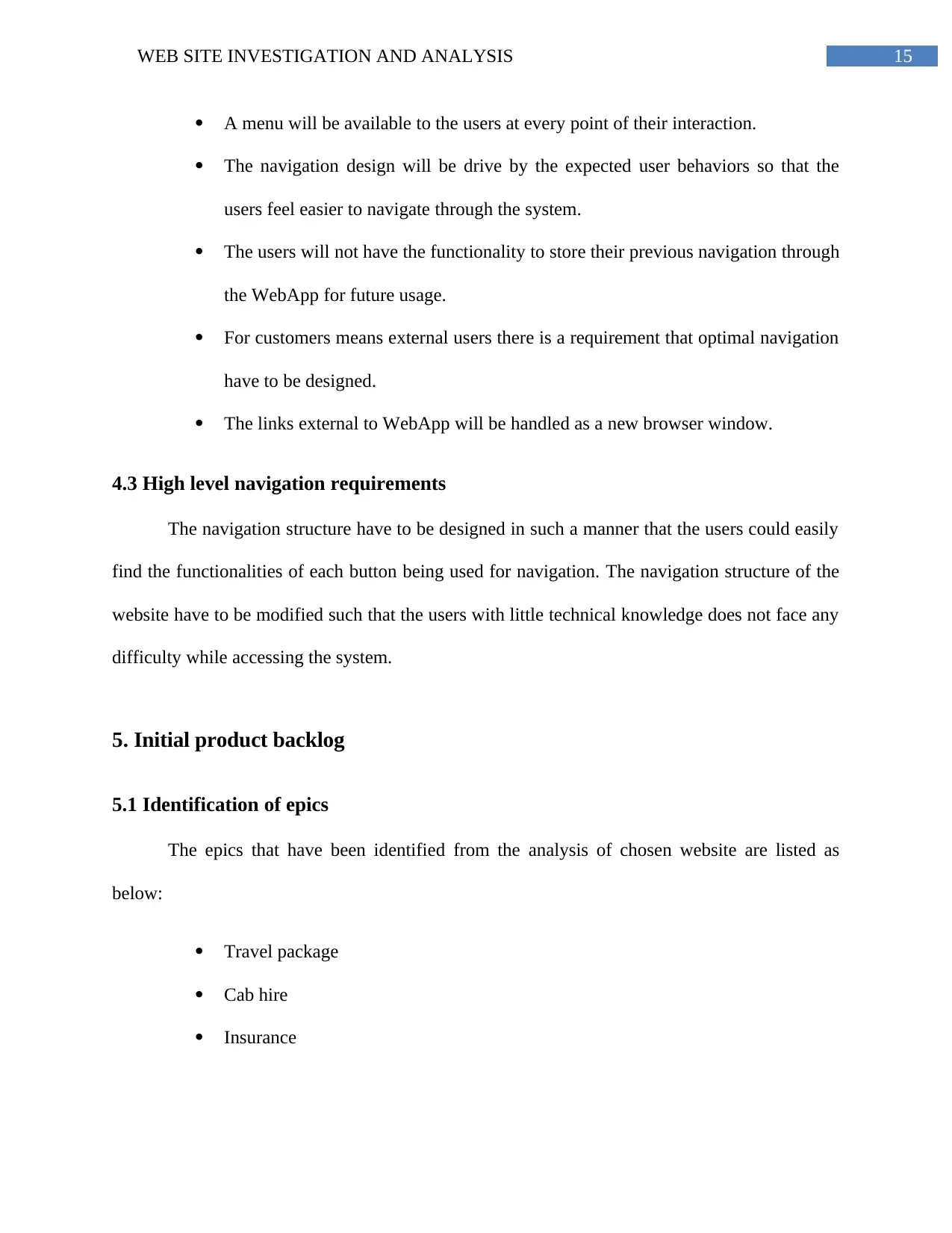
15WEB SITE INVESTIGATION AND ANALYSIS
A menu will be available to the users at every point of their interaction.
The navigation design will be drive by the expected user behaviors so that the
users feel easier to navigate through the system.
The users will not have the functionality to store their previous navigation through
the WebApp for future usage.
For customers means external users there is a requirement that optimal navigation
have to be designed.
The links external to WebApp will be handled as a new browser window.
4.3 High level navigation requirements
The navigation structure have to be designed in such a manner that the users could easily
find the functionalities of each button being used for navigation. The navigation structure of the
website have to be modified such that the users with little technical knowledge does not face any
difficulty while accessing the system.
5. Initial product backlog
5.1 Identification of epics
The epics that have been identified from the analysis of chosen website are listed as
below:
Travel package
Cab hire
Insurance
A menu will be available to the users at every point of their interaction.
The navigation design will be drive by the expected user behaviors so that the
users feel easier to navigate through the system.
The users will not have the functionality to store their previous navigation through
the WebApp for future usage.
For customers means external users there is a requirement that optimal navigation
have to be designed.
The links external to WebApp will be handled as a new browser window.
4.3 High level navigation requirements
The navigation structure have to be designed in such a manner that the users could easily
find the functionalities of each button being used for navigation. The navigation structure of the
website have to be modified such that the users with little technical knowledge does not face any
difficulty while accessing the system.
5. Initial product backlog
5.1 Identification of epics
The epics that have been identified from the analysis of chosen website are listed as
below:
Travel package
Cab hire
Insurance
Secure Best Marks with AI Grader
Need help grading? Try our AI Grader for instant feedback on your assignments.
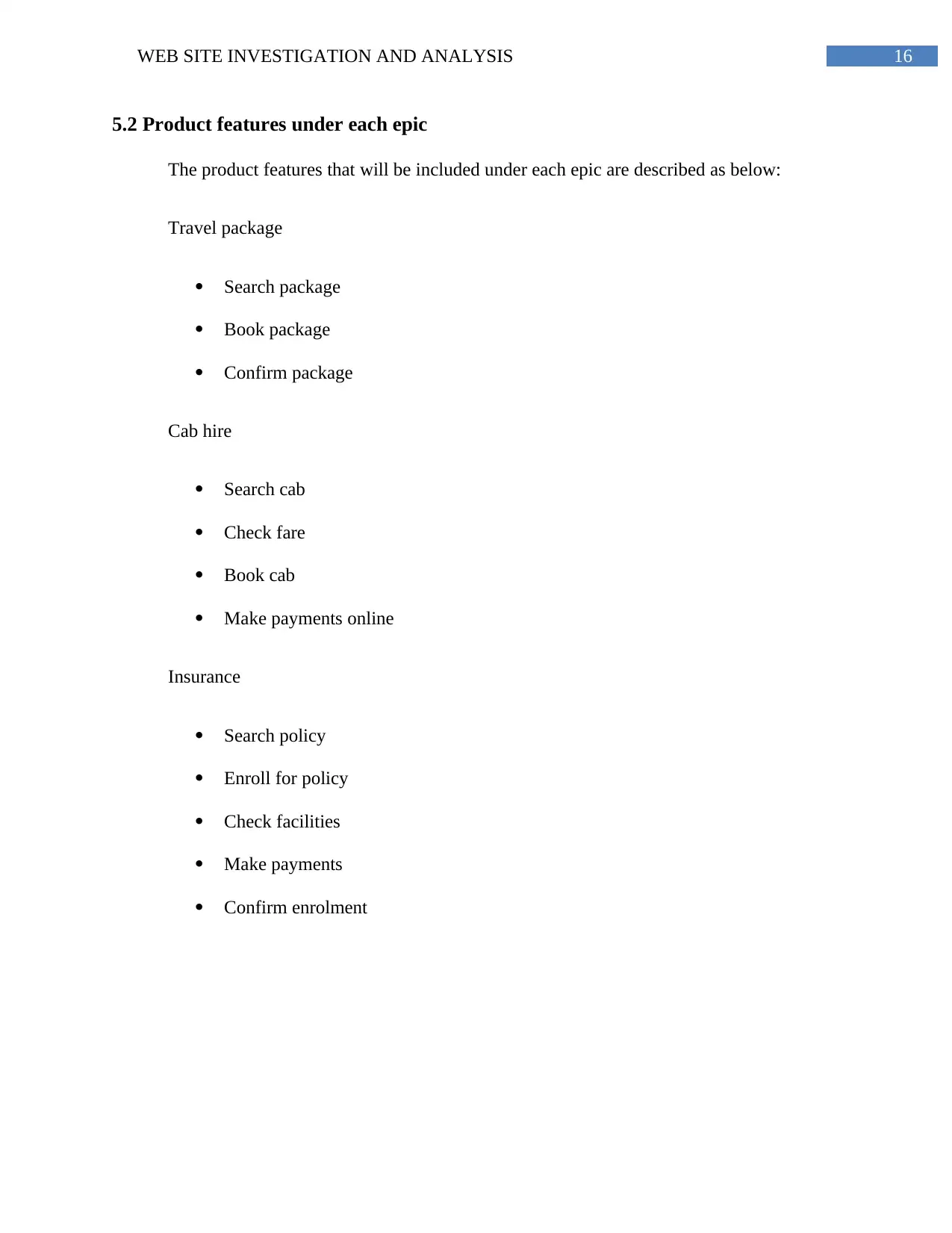
16WEB SITE INVESTIGATION AND ANALYSIS
5.2 Product features under each epic
The product features that will be included under each epic are described as below:
Travel package
Search package
Book package
Confirm package
Cab hire
Search cab
Check fare
Book cab
Make payments online
Insurance
Search policy
Enroll for policy
Check facilities
Make payments
Confirm enrolment
5.2 Product features under each epic
The product features that will be included under each epic are described as below:
Travel package
Search package
Book package
Confirm package
Cab hire
Search cab
Check fare
Book cab
Make payments online
Insurance
Search policy
Enroll for policy
Check facilities
Make payments
Confirm enrolment
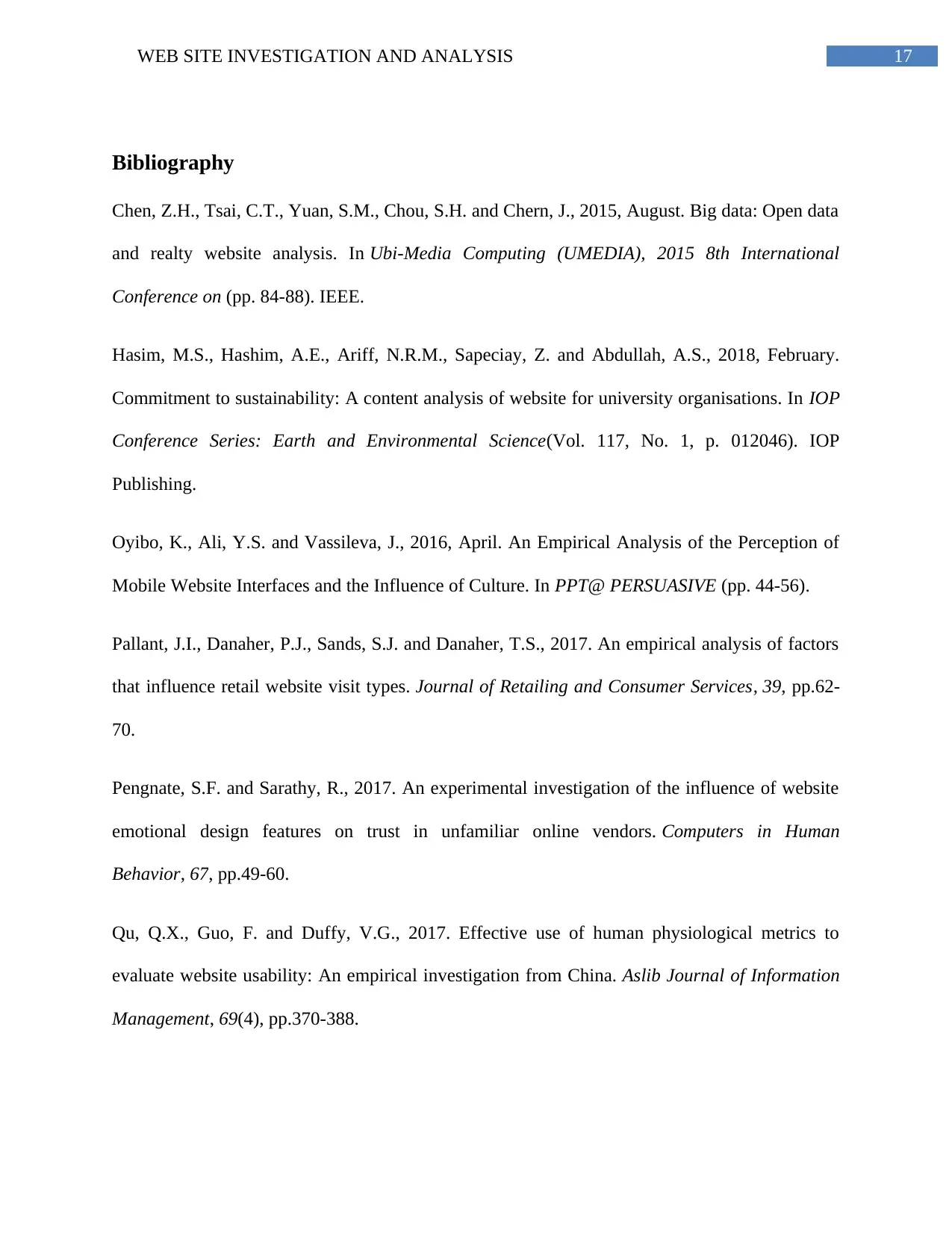
17WEB SITE INVESTIGATION AND ANALYSIS
Bibliography
Chen, Z.H., Tsai, C.T., Yuan, S.M., Chou, S.H. and Chern, J., 2015, August. Big data: Open data
and realty website analysis. In Ubi-Media Computing (UMEDIA), 2015 8th International
Conference on (pp. 84-88). IEEE.
Hasim, M.S., Hashim, A.E., Ariff, N.R.M., Sapeciay, Z. and Abdullah, A.S., 2018, February.
Commitment to sustainability: A content analysis of website for university organisations. In IOP
Conference Series: Earth and Environmental Science(Vol. 117, No. 1, p. 012046). IOP
Publishing.
Oyibo, K., Ali, Y.S. and Vassileva, J., 2016, April. An Empirical Analysis of the Perception of
Mobile Website Interfaces and the Influence of Culture. In PPT@ PERSUASIVE (pp. 44-56).
Pallant, J.I., Danaher, P.J., Sands, S.J. and Danaher, T.S., 2017. An empirical analysis of factors
that influence retail website visit types. Journal of Retailing and Consumer Services, 39, pp.62-
70.
Pengnate, S.F. and Sarathy, R., 2017. An experimental investigation of the influence of website
emotional design features on trust in unfamiliar online vendors. Computers in Human
Behavior, 67, pp.49-60.
Qu, Q.X., Guo, F. and Duffy, V.G., 2017. Effective use of human physiological metrics to
evaluate website usability: An empirical investigation from China. Aslib Journal of Information
Management, 69(4), pp.370-388.
Bibliography
Chen, Z.H., Tsai, C.T., Yuan, S.M., Chou, S.H. and Chern, J., 2015, August. Big data: Open data
and realty website analysis. In Ubi-Media Computing (UMEDIA), 2015 8th International
Conference on (pp. 84-88). IEEE.
Hasim, M.S., Hashim, A.E., Ariff, N.R.M., Sapeciay, Z. and Abdullah, A.S., 2018, February.
Commitment to sustainability: A content analysis of website for university organisations. In IOP
Conference Series: Earth and Environmental Science(Vol. 117, No. 1, p. 012046). IOP
Publishing.
Oyibo, K., Ali, Y.S. and Vassileva, J., 2016, April. An Empirical Analysis of the Perception of
Mobile Website Interfaces and the Influence of Culture. In PPT@ PERSUASIVE (pp. 44-56).
Pallant, J.I., Danaher, P.J., Sands, S.J. and Danaher, T.S., 2017. An empirical analysis of factors
that influence retail website visit types. Journal of Retailing and Consumer Services, 39, pp.62-
70.
Pengnate, S.F. and Sarathy, R., 2017. An experimental investigation of the influence of website
emotional design features on trust in unfamiliar online vendors. Computers in Human
Behavior, 67, pp.49-60.
Qu, Q.X., Guo, F. and Duffy, V.G., 2017. Effective use of human physiological metrics to
evaluate website usability: An empirical investigation from China. Aslib Journal of Information
Management, 69(4), pp.370-388.
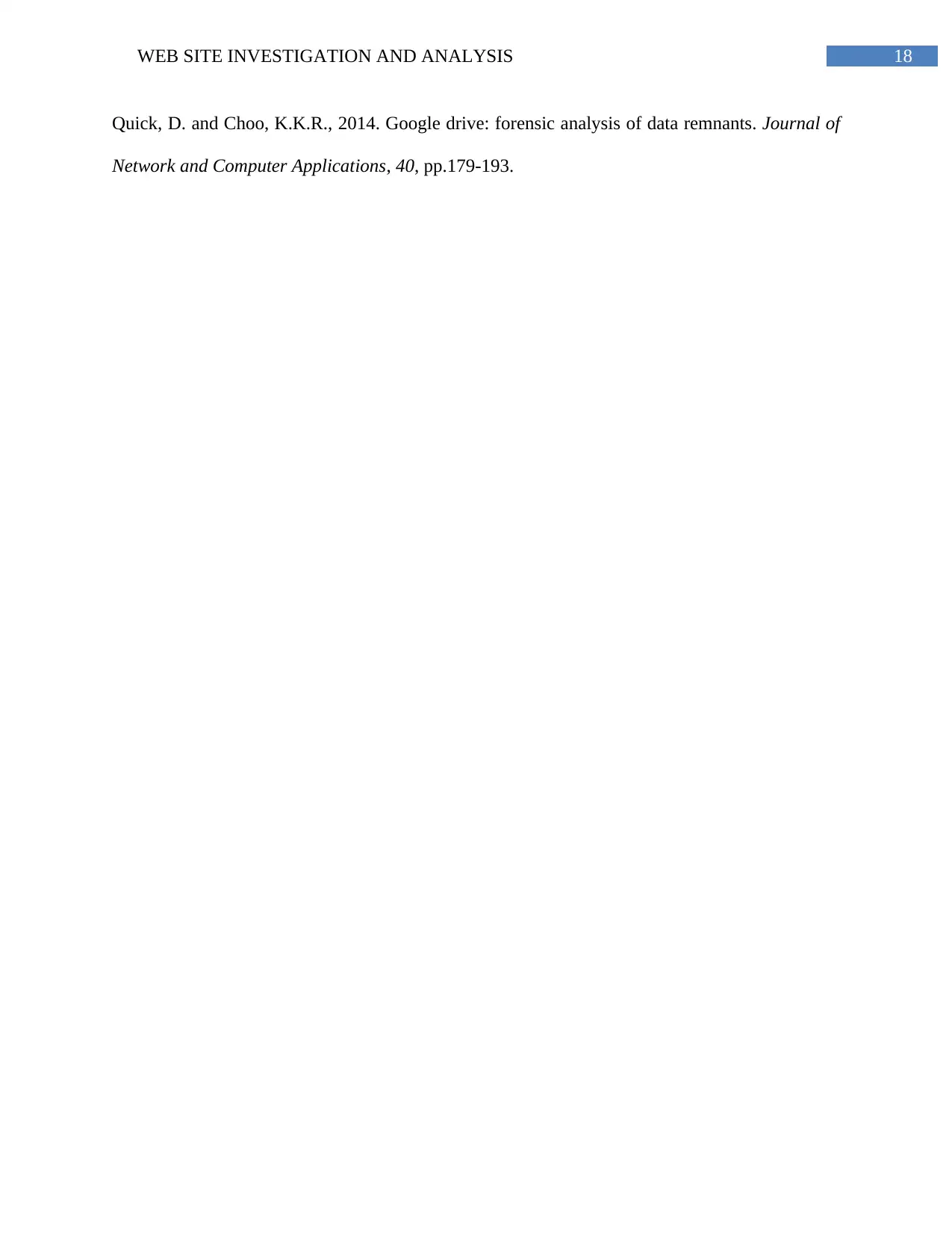
18WEB SITE INVESTIGATION AND ANALYSIS
Quick, D. and Choo, K.K.R., 2014. Google drive: forensic analysis of data remnants. Journal of
Network and Computer Applications, 40, pp.179-193.
Quick, D. and Choo, K.K.R., 2014. Google drive: forensic analysis of data remnants. Journal of
Network and Computer Applications, 40, pp.179-193.
1 out of 19
Related Documents
Your All-in-One AI-Powered Toolkit for Academic Success.
+13062052269
info@desklib.com
Available 24*7 on WhatsApp / Email
![[object Object]](/_next/static/media/star-bottom.7253800d.svg)
Unlock your academic potential
© 2024 | Zucol Services PVT LTD | All rights reserved.




